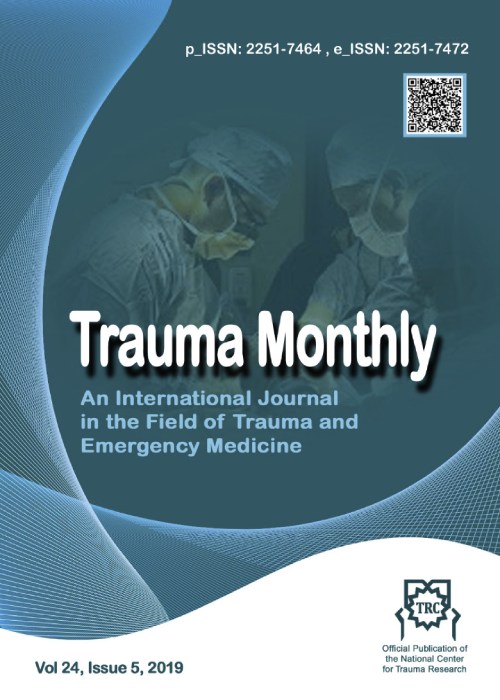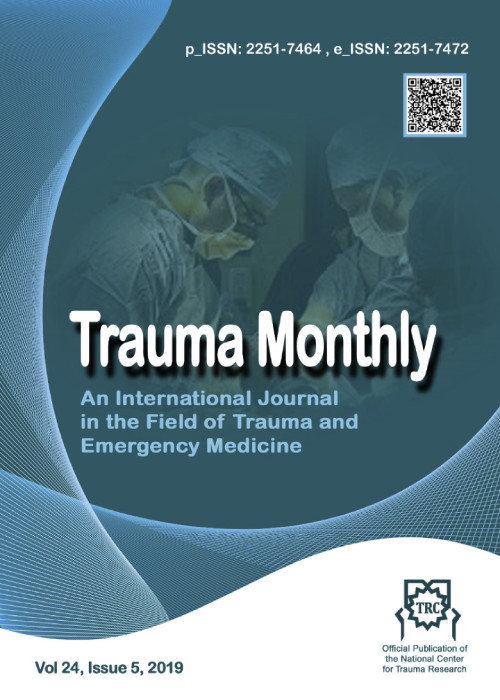فهرست مطالب

Trauma Monthly
Volume:28 Issue: 3, May-Jun 2023
- تاریخ انتشار: 1402/05/15
- تعداد عناوین: 7
-
-
Pages 805-814IntroductionThe reduction of thyroid hormones during surgery can affect the amount of bleeding. This study aimed to evaluate the effects of prophylactic administration of oral levothyroxine on bleeding and hemoglobin levels during and after THA in patients with a history of IHD.MethodsIn this double-blinded clinical trial, 40 THA candidates with a history of IHD were randomly divided into intervention and control groups. Twelve hours before the induction of anesthesia, patients in the intervention group received 20 µg levothyroxine, and patients in the placebo group received the same amount (one-fifth of a tablet) of a placebo. Also, during surgery, one tablet containing either 100 mg levothyroxine or a placebo was dissolved in 30 ml of water, and 20% of it was fed to the patients by gavage. One, two, three, and 12 hours after surgery, as well as on days 1st, 2nd, and 4th post-surgery, the same amount of the drug was given to the patients. Changes in hemoglobin level, bleeding volume (during and after surgery), and the number of blood units received were compared between the two groups.ResultsRed blood cell count (RBC) (intervention: P=0.855 and control: P=0.214), hemoglobin level (intervention: P=0.673 and control: P=0.123), and hematocrit (intervention: P=0.666 and control: P=0.096) were more stable in the intervention than in the control group. Also, bleeding volume was considerably lower in the intervention group (P=0.339) than in the control group (P=0.032). Also, serum volume in the operation room (P=0.019) and post-surgery (P=0.041) and the number of packed cell units received in the operation room (P=0.014) and after surgery (P=0.041) were significantly lower in the intervention group than in the control group.ConclusionThe prophylactic administration of oral levothyroxine reduced bleeding volume and the need for blood transfusion and rendered blood indices (Hb, HCT, RBC, PT, and APPT) more stable in THA candidates with a history of IHD.Keywords: Bleeding, Hemoglobin, Total Hip Arthroplasty, Cardiovascular Diseases
-
Pages 815-822Background
Education is one of the essential pillars for developing abilities, skills, knowledge, and competencies in society. As there is a necessity to use new educational methods in universities due to the rapid changes in science, we aimed to compare the effect of scenario-based training versus video training on pre-hospital triage knowledge and skills of nurse anesthesia students.
MethodsAmong 45 students who participated in the study, the mean age was 21.57±3.42 years (minimum 19 and maximum 43 years). Forty-five nurse anesthesia students of Ahvaz Jundishapur University of Medical Sciences participated. All cases were divided into three groups, including scenario-based training, video training, and control. The knowledge questionnaire and pre-hospital triage skill assessment checklists were completed before and after the intervention.
ResultsThere was a significant difference between the pre-hospital triage knowledge and skill scores of the students before and after the educational intervention based on the scenario and the use of video (p<0.001). In contrast, this difference was not significant in the control group. Also, the mean triage knowledge and skills scores in the scenario training group were higher than in the video training group (p<0.001).
ConclusionThe effect of post-scenario-based education on active participation, critical thinking, intellectual abilities, and creativity is more effective than video training for teaching essential topics such as pre-hospital triage.
Keywords: Education, Nursing, Triage, Nurse Anesthetists, Simulation Training -
Pages 823-830Introduction
Implantable cardiac defibrillators (ICDs) are commonly used to prevent sudden death in patients with heart failure. This study aims to determine patients' mortality rate and predictors in the first year after ICD implantation.
MethodsThe study was a historical cohort based on patients who underwent ICD implantation at the Baqiyatallah Hospital from March 2009 to March 2018. ICD Implantation was used as secondary prevention for the patients.
Results777 ICD Implanted patients, including 27.5% females and 72.5% males with a mean age of 64.2 ± 0.8 63.5 ± 12.7 years, were included in the study. The mean one-year survival was 11.29 ± 0.1 months. In multivariate analysis, age>75, hypertension, chronic obstructive pulmonary disease, chronic kidney disease, and hyponatremia were significantly correlated with shorter survival time.
ConclusionsOld age, chronic kidney or lung disease, hyponatremia, hypertension, and anemia are independent predictors of first-year survival in patients with an ICD implantation for heart failure.
Keywords: First-year mortality, Heart failure, Implantable Cardiac Defibrillators -
Pages 831-840Introduction
Emergency department (ED) overcrowding may damage patient outcomes in various settings. This systematic review investigated the association between ED crowding and patient mortality.
MethodsA search of three electronic databases namely Medline, EMBASE, and Web of Science websites was done to identify all original English language published studies concerning mortalities caused by ED crowding between January 1999 and January 2019.
ResultsA total of 45 studies were included in the full-text review. After excluding 17 studies because of poor quality, 28 articles were included in the final review. Twenty articles reported a direct association between ED crowding and emergency patient mortality. With the increase in ED overcrowding, mortality also increased. Nevertheless, eight of the studies reported no association between ED crowding and mortality.
ConclusionED overcrowding significantly increased patient mortality regardless of the amount of ED overcrowding and type of diseases in most studies were assessed in this study. Additional studies are required to comprehensively assess the relationship between ED overcrowding and patients’ mortality.
Keywords: Emergency, crowding, mortality -
Pages 841-849Introduction
Cell therapy is broadly applied to the cure of the majority of diseases, particularly Traumatic Brain Injury) TBI). The study aimed to review cell therapy in the treatment of TBI.
MethodOnline databases such as Scopus, ISI Web of Knowledge, and PubMed were searched. Keywords used were traumatic brain injury, cell therapy, and human neural stem cells. Two reviewer authors individually searched and assessed the abstracts and titles; a third reviewer resolved disagreements. Data documented cited study location, type of complications, various traumatic brain injuries and type of neural stem cell, and cell transplantation.
ResultsSeven studies, including two studies regarding stem cell therapy after chronic TBI, one study about the Treatment of Severe Adult Traumatic Brain Injury using Bone Marrow Mononuclear Cells, and four records about Transplantation and Migrate Stem Cells were included. Treating severe adult traumatic brain injury using an intravenously delivered autologous bone marrow mononuclear cell infusion proved safe and logistically feasible. Inflammatory biomarkers are downregulated after cell infusion. Data indicated that Stem Cells migrate to sites of TBI damage and that their presence correlates with cognitive improvement. The results validated the potential of Cryobanked Human Neural Stem Cells to improve function after TBI and demonstrate long-term bio-banking effects.
ConclusionMature stem cells have demonstrated prospective novel situations for TBI Cell therapy. Novel approaches could use biological matrices that allow cell survival and separation of grafted stem cells in excellent ratios compared to standard treatment.
Keywords: Traumatic Brain Injury, cell therapy, Stem cell therapy -
Pages 850-855Introduction
Pleural effusion (PLEFF) is mainly caused by volume overload, heart failure, trauma, and pleuro-pulmonary infection, it is common in emergency and ICU patients. Although the function of ultrasonography in detecting PLEFF has long been noted, controversial results have been reported. This study aimed to review the literature on ultrasound and radiography in detecting PLEFF.
MethodsA search was done in Medline, ISI Web of Knowledge, EMBASE, and Scopus databases. Two reviewers independently searched, screened, and included the data and a third author resolved any conflict.
ResultsThe findings proved that as a screening tool, chest ultrasound has greater diagnostic accuracy in identifying multiple pleural effusions than radiography. Chest ultrasound enables clinicians visualize pleural effusions and also helps differentiate between various types. In addition, chest ultrasound is crucial for thoracentesis and thoracostomy drainage as it enhances safeness and reduces life-threatening complications. This is important not only when inserting a needle or tube drain, but also when monitoring the amount of her PLEFF deflated. In addition, chest ultrasound is often more specific and sensitive than chest radiography, helping to diagnose coexisting lung disease without X-ray exposure.
ConclusionThoracic Ultrasound (TUS) is a simple, non-invasive, bedside procedure for diagnosing PLEFF with greater sensitivity and specificity than a chest X-ray. This is crucial for visualizing exudate and helps differentiate various forms of her PLEFF. More recently, ultrasound has been used to guide thoracentesis and insert chest tubes to raise the safeness of this invasive method, especially if an ICU patient is on a ventilator or has a small localized pleural effusion. Additionally, TUS can monitor the PLEFF drainage and determine when to extract the drainage.
Keywords: Ultrasonography, CT scan, Radiology, Pleural Effusion -
Pages 856-858
Recently many reports have remarked raised mortality for various reasons in the summer monthes in extremely high weather temperatures. Heatwave is when the weather is hotter than usual and is a public health hazard. Climate change poses global health risks. To sufficiently rescue patients from heat waves and utilize public resources, it is necessary to comprehend were daytime heat waves raise mortality risk. The findings proved the necessity of developing warning techniques in summer. Public health workers should take action to educate communities on the health risks of heat waves and teach them how important it is to reduce exposure to heat and increase access to a cool environment. Policymakers should execute an early warning system to control negative heat wave impacts on patients, including early alerts and advisories, and implement various emergency measures to mitigate the heat dangers. Meanwhile, adding staff and increasing their rotation for hospitals, clinics, and health care during heat waves is essential. In religious ceremonies during summer, critical care of vulnerable people should be considered.
Keywords: Heatwave, Critical Care, Cardiovascular disease


